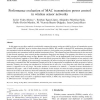Free Online Productivity Tools
i2Speak
i2Symbol
i2OCR
iTex2Img
iWeb2Print
iWeb2Shot
i2Type
iPdf2Split
iPdf2Merge
i2Bopomofo
i2Arabic
i2Style
i2Image
i2PDF
iLatex2Rtf
Sci2ools
CN
2007
2007
Performance evaluation of MAC transmission power control in wireless sensor networks
In this paper we provide a method to analytically compute the energy saving provided by the use of transmission power control (TPC) at the MAC layer in wireless sensor networks (WSN). We consider a classical TPC mechanism: data packets are transmitted with the minimum power required to achieve a given packet error probability, whereas the additional MAC control packets are transmitted with the nominal (maximum) power. This scheme has been chosen because it does not modify the network topology, since control packet transmission range does not change. This property also allows us to analytically compute the expected energy savings. Besides, this type of TPC can be implemented in the current sensor hardware, and it can be directly applied to several MAC protocols already proposed for WSN. The foundation of our analysis is the evaluation of L ratio, defined as the total energy consumed by the network using the original MAC protocol divided by the total energy consumed if the TPC mechanis...
| Added | 12 Dec 2010 |
| Updated | 12 Dec 2010 |
| Type | Journal |
| Year | 2007 |
| Where | CN |
| Authors | Javier Vales-Alonso, Esteban Egea-López, Alejandro S. Martínez-Sala, Pablo Pavón-Mariño, M. Victoria Bueno-Delgado, Joan García-Haro |
Comments (0)

